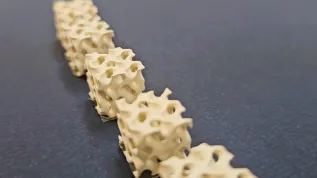
‘We would not talk about AI art if there was no human behind it’, Professor Anna Maj from the University of Silesia told PAP at the four-day EuroScience Open Forum (ESOF) in Katowice, during which specialists discussed topics such as digital innovation.
'In the case of one of the works presented during the panel, we were dealing with a dialogue of two neural networks. However, this dialogue would not have taken place without the artist’, Professor Maj said.
ESOF was a four-day scientific conference on the relationship between science and society, the conditions for conducting scientific research and its impact on society. Its aim is to stimulate debate on science-related topics and analyse the social, cultural and economic consequences of groundbreaking scientific discoveries.
'All AI is based on human achievements, and this knowledge is not invented by AI. As long as it is not a conscious entity, it is not an average of human achievements', explained Piotr Ceglarek from the Academy of Fine Arts in Katowice.
The theme of the conference is 'Life changes science'. It concerns transformation in several areas - energy, health, environment, social and digital. Digital transformation was discussed by specialists from the Centre for Research on New Media Art, Culture and Technology of the University of Silesia during a panel on 'new media'.
'New technologies give rise to new possibilities. And just like with every technology in the history of humanity - humanity uses them: from engineers to artists. Each new technology is another tool for creators, i.e. new media', explained Professor Marian Oslislo from the Academy of Fine Arts in Katowice.
According to the panelists, there are many genres of new media art. Some of these genres have evolved from previously existing ones, such as digital music, animation or VR.
'We also have typically new media genres, i.e. hybrid art, interactive art, which shifts the emphasis in a different direction, for example to the sense of touch in the case of interactive art. We also have robotic art, bioart, and many different genres', said Professor Maj.
She added that AI Art had become another genre used by artists. However, art does not have to be created only by artists.
'We can do much more now than before. Previously, this knowledge was different because it came from our activities, and we did not have these tools. The world is constantly changing, and anyone can create a work of art', added Professor Oslislo.
In a conversation with the panelists, PAP journalists referred to the work of the German artist Boris Eldagsen, titled Pseudomnesia: The Electrician, which won the Sony World Photography Awards competition. After the results were announced in April 2023, the photographer refused to accept the award. He explained that the photo was generated by artificial intelligence.
When asked whether it is possible to recognize art that has been supported by artificial intelligence - and whether there should be a separate competition category for such art, specialists agreed that the assessment of AI art should be systematized.
'In some cases, to some extent, we are able to say that something is AI-assisted work. We can still tell', said Professor Maj. 'We are unlikely to get rid of this problem, and it is a matter of responsibility of people and the art market'.
Events as part of the European City of Science 2024 in Katowice continue throughout the year. Fifty thematic weeks have been prepared for this occasion, during which scientific issues from various fields are presented. They include: Crystal Week (June 10-16), Future Transport Week (June 17-23) and Silesia Week (June 24-30).
ESOF2024 was organized by the EuroScience Association, the Katowice City Hall and the University of Silesia, which is the leader of the Academic Consortium Katowice - City of Science 2024. Other universities included in the consortium are also involved in the event: Academy of Music in Katowice, Academy of Fine Arts in Katowice, Academy of Physical Education in Katowice, Silesian University of Technology, Medical University of Silesia in Katowice and University of Economics in Katowice. (PAP)
Julia Szymańska
jms/ zan/ js/ kap/
tr. RL













